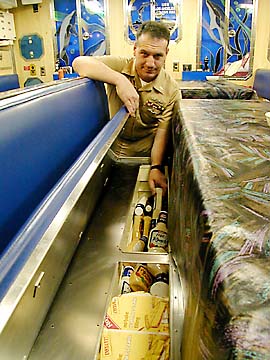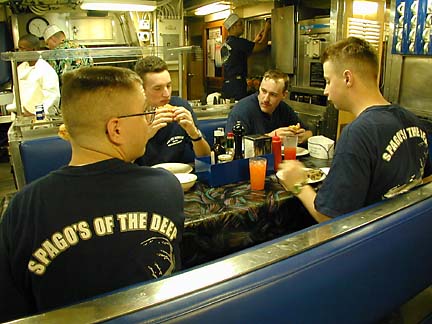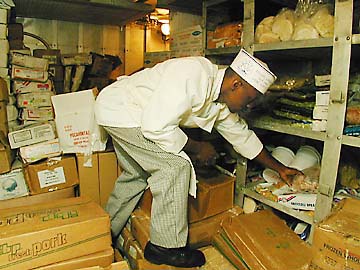


Aboard the nuclear submarine
By Betty Shimabukuro
USS Los Angeles, the galley crew
runs a 24-hour restaurant in
the space of an average-
sized kitchen
Star-BulletinLife on a submarine means sleeping on bunks stacked three high on matresses only a few inches thick and barely as long as your body. It means sharing three toilets and two showers with 100 other guys. And having to turn sideways whenever you pass someone in the "halls."
Man, the food had better be good.
"Ninety-nine percent of the morale is here." Chief Kevin "Rusty" Staub gestures around the main mess of the USS Los Angeles. "This is it."
The nuclear-powered submarine is equipped to carry Tomahawk cruise missiles, MK-48 torpedos and both variants of the navy's submarine-launched mines. It can also carry 18,000 pounds of frozen meat and 20,000 pounds of canned goods to last three months at sea.
And so it did, when it pulled out of its homeport of Pearl Harbor a few weeks ago.
Staub -- leading mess specialist, or "head stew burner," on the Los Angeles -- must keep up to 150 submariners fed and happy during deployments that may keep them at sea for months at a time. He is, in essence, the restaurant manager for an operation that runs 24 hours a day, serving breakfast, lunch, dinner and a midnight repast. Not to mention the soup pot that is always in service.
The cooks in his employ do this in a 10-foot-by-12-foot kitchen that has a tendency to pitch and roll.
Staub says the work performed is the equivalent of running a daily "kau-kau wagon" for the men in the mess to "full-formal, seven-course, no-holds-barred meals," complete with good silver and waiters, for visiting dignitaries.

Not many restaurants on solid ground have that kind of flexibility.This is what they have to work with: two ovens, a fryer, two boiler pots and a griddle. Also, a freezer that's roughly the same size as the entire galley and is packed floor-to-ceiling with food -- a 90-day-supply. It must be meticulously keyed to the daily menus so that the food needed for the first meals are immediately inside the freezer door. Rooting around for a missing chuck roast is out of the question.
A separate storage room holds dry and canned food, plus the few fresh items taken onboard: cabbage, potatoes, carrots, onions, and one case each of apples and oranges.
Clean-as-you-go is the byword; dirty dishes take up space, and when they're lying around, they could get broken, what with the kitchen being in motion.
Actually, Staub says, a sub at sea normally feels quite still, it's at those high altitudes near the surface that the ride gets rocky. Still, the kitchen is prepared. Oven doors latch shut, as do all the drawers. Every pan put in the oven is sealed to prevent spillage. The fryer is 14 inches deep. "We can take a 25 degree up angle and the hot grease won't come out," Staub says.
What are they eating? In general, 200 pounds of meat per day, 25 pounds of rice, 25 loaves of bread and 500 cookies.

Specifically, on Saturday nights, pizza and buffalo wings (a submarine tradition); Sundays, prime rib or steak with shrimp; Italian night once a week, featuring fresh-baked French bread and entrees including lasagne, manicotti and spaghetti with meat or clam sauce.Across-the-board favorites, though, are the Mexican meals, often featuring a Los Angeles specialty, enchiladas. They get crab legs, too, and lumpia, Chinese Five-Spice Chicken, French onion soup -- and every day, a salad bar.
Navy food has changed over the years, Staub says. "It was big, heavy, hearty stews and roast beef and big mashed-potato meals." Nowadays it's lighter, with all the standard recipes revamped to cut salt and fat. Galleys must also be prepared to accommodate vegetarians and crew members with dietary needs dictated by religion.
The reviews have been positive. Comments from Kevin Lang, a sonar technician, are typical. The Los Angeles is his third submarine in nine years in the Navy -- "a pretty extensive amount of feed time, I guess."

He pronounces the dining experience here to be the best by far. "The food is similar, but the preparation and the quality of the preparation is much better."Typical training for a mess specialist is eight weeks of Navy cooking school, which focuses more on math, science and sanitation than on recipes. "Basically you learn how to be safe on a ship, then you come here and the guys on board teach you," Staub says.
After some time on the job, a cook might be sent to a culinary institute for a couple of months.
Final culinary fact about submarines: The navy allows 50 cents more per meal per man on a sub vs. a surface ship. It's a reflection of the isolated nature of the job, and although it doesn't seem like much, it does add up, Staub says. "We eat a little better just because we can afford to."
This recipe from the USS Los Angeles was formulated for 100 servings, which is the typical cooking task facing the submarine's mess specialists. It has been reduced in size for home cooking. Chicken a la 'Spago of the Deep'
Rinse and drain chicken pieces. Combine soy sauce with onions, garlic and ginger; mix well. Pour over chicken and marinate 30 minutes, turning frequently. Drain. Place chicken on lightly greased sheet pans, skin side up.CHINESE FIVE-SPICE CHICKEN
6-1/2 pounds chicken pieces
1-1/3 cups soy sauce
2/3 cup chopped onions
3 minced garlic cloves
2 teaspoons ground ginger
1 teaspoon ground cinnamon
1 teaspoon ground cloves
1/4 teaspoon ground black pepperCombine cinnamon, cloves and pepper. Sprinkle over chicken. Bake at 350 degrees for 1 hour, or until cooked through. Serves 10.
Approximate nutritional analysis per serving (chicken breast with skin): 435 calories, 22 g total fat, 6 g saturated fat, 150 mg cholesterol, greater than 2,000 mg sodium.*
Click for online
calendars and events.